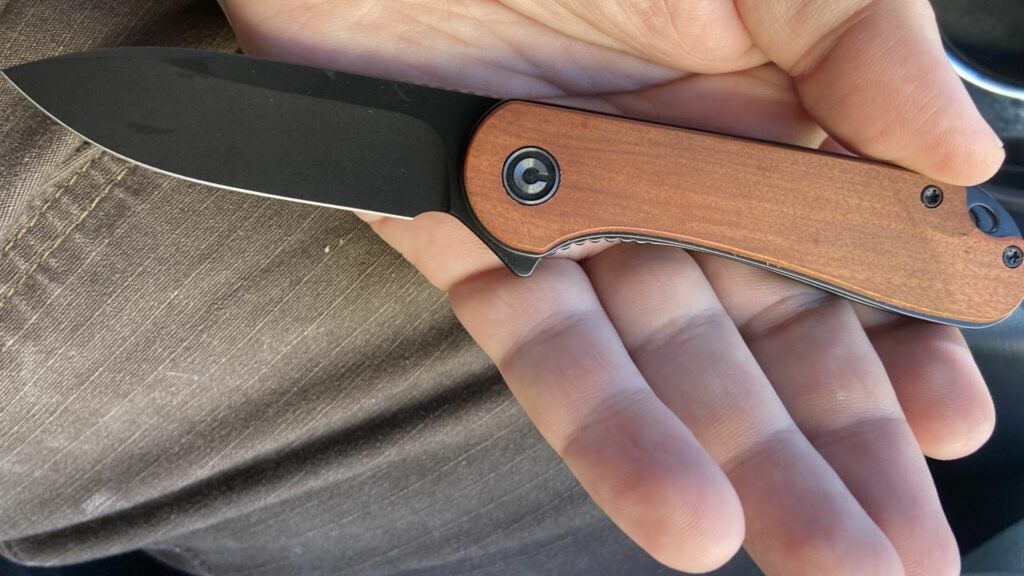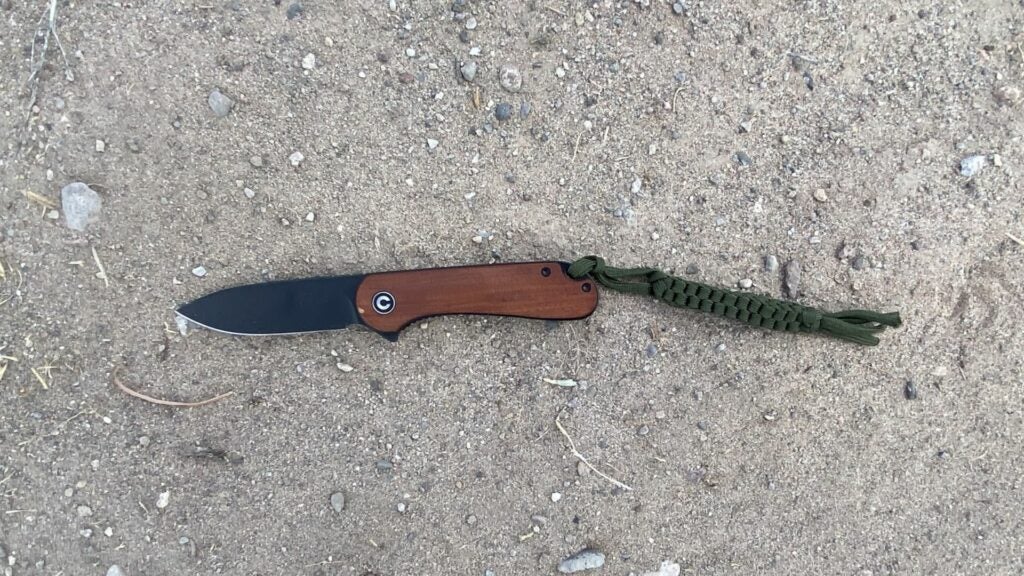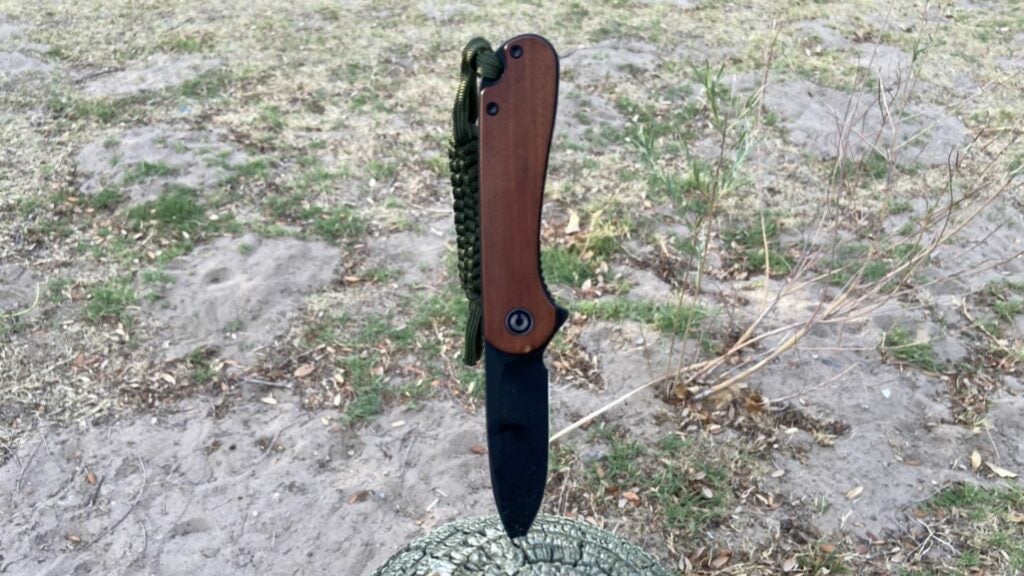I was born and raised in West Virginia, where every person I knew growing up had some sort of fixed blade knife attached to their hip. Today, many outdoorsy West Virginians have transitioned to carrying a gun on their hip, but back in the 1990s, lots of folks regularly carried big, cheap knives they picked up at a flea market. My grandpa made fun of them constantly as they would walk in and out of bait shops on their way to fish in the Cranberry Glades. Paw would look at them and even sarcastically shout out the window, “hey Tex, where ya headin’ with that iron on ya hip?” in a tone only a World War II Army sergeant could muster. He’d turn to me and say, don’t ever buy or wear something like that, just get one like this Old Timer folder.
That lesson has stuck with me to this day and followed me throughout my U.S. military career as well: Always opt for practicality over doing something for show. I’m not quite the man my grandpa was, but the Civivi Elementum folding pocket knife the company sent to us might just be the knife that replaces your blades of bygone eras.
Blade length: 2.96 in
Weight: 2.89 oz
Materials: D2 steel (blade), cuibortia wood (handle)
Unboxing
The Civivi Elementum packaging blows higher-end knife companies out of the water. The exterior white box contains a nylon zipper pouch lined with plush material to protect the knife while in transport. The knife itself is wrapped in plastic and slides out of the pack with a nice fiber cloth for cleaning. Often, more expensive knives will come only with the knife and the expectation you will purchase additional items from their stores. Civivi gives you everything you need for maintenance minus some oil and a sharpening stone. Everything they sell comes in this style and the zipper pouches make for a nice package to put in a drawer when not in rotation.

The knife itself is impressive, and its design features make it one of the best simple utility knives on the market. Civivi was kind enough to send the stunning high-end model with nicer materials for our testing. The handles bear a slim-cut cuibortia wood with horizontal grains that would look perfect on a high-end writing desk, although I broke a sliver of the wood off (sorry, Civivi!) while using the knife during a camping trip in the mountains of New Mexico. The knife has a black stone-washed blade that matches its wooden handles for the perfect mixture of class and utility. On the tail end of the knife, it offers a nice lanyard hole for the user to provide a little extra retention in the hand.
The knife felt like I’d owned it for 20 years when I opened it up for the first time. The black blade measures just shy of three inches, and the entire knife with handle measures just shy of seven inches when fully extended. The back flipper tab flips perfectly into action and dissolves into your hand. The drop point blade is a little too short for serious work, and the material may be a little too weak to strip cables with it as an electrician. The pocket clip rests on the right side of the wooden handle, and unfortunately does not apply to the other side of the blade. The blade provides a perfectly ergonomic handle to grasp and looks great for the price.
How we tested the Civivi Elementum

The first things I did with this knife were tested its sharpness on a sheet of paper and saw if it would shave the hair off my arm without pain. The knife is very sharp but has a little trouble passing through a piece of paper without tearing it. That is not to say the knife isn’t sharp out of the box — it’s sharper than most blades — but it needs a little extra help to get to the razor-sharp quality that I prefer. Further, the black stain on the blade will certainly scar when sharpening. If a blade won’t pass through a sheet of paper, it likely won’t shave the hair off your body either; indeed, I attempted but failed to shave hair off my arm. With a little manipulation, you can still slice through a piece of paper like a razor blade, but if you want it sharper, you will have to do it yourself.
I just moved to the desert in New Mexico and all my household goods were delivered the same week as this knife, so I sliced up box after box from the move and from new appliances we had delivered. The knife works well for me as a right-handed person, and easily clips to my right pocket while carrying heavy boxes back and forth. Surprisingly, despite this knife’s difficulty with the sheet of paper, it slices through cardboard boxes easier than my Gerber Prybrid straight razor. It’s most likely due to the formidable blade that the Prybrid simply can’t offer.
I intentionally abused the blade to see if it could hold an edge through the boxes and after a week of cutting five to six boxes apart a day, the knife still retains both its edge and the black stone wash. With just a few wipes from the cloth that Civivi provides, you can’t even see the blemishes that cardboard usually produces on a blade like this.
What we like about the Civivi Elementum
Civivi has again made a remarkably cheap, ergonomically designed utility knife. The way this knife felt in my hands made me forget that this was a knife I’d purchased. It felt almost too smooth in the hands and is easy to manipulate with gloves on. The knife held its edge throughout the testing process and will continue to hold its edge for some time. I’ve cut so many thick cardboard boxes that this knife should be as dull as a butter knife by now, but it’s still slicing through almost everything like it were butter.
I love the wood on black stone-washed steel piece that Civivi sent us. Most of us likely don’t select a knife on the look alone, but this one offers a subtle high-end motif that won’t make you look like a knife guy. The blackened blade looks great, but for everyday tasks, I do recommend purchasing the model with G10 or Micarta scales. Furthermore, the blackened blade will most likely scratch if you’re using it on hard materials, but it will still look great.

Despite some weakness in the higher-end materials used in it construction, I believe in the Elementum’s simple design with maximum value. For around $60, a consumer can buy a gorgeous gentleman’s knife or simply an everyday pocket knife that replaces the old nail nick openers from the 1980s. The simplicity of this knife shouldn’t be overlooked, and I contend this is, potentially, a modern classic.
What we don’t like about the Civivi Elementum
The wooden scales look amazing, but they’re far from durable. I’ve taken this knife on a few camping trips and chipped the scales in two different locations. The work I’ve done with the knife is not hard use, simply slicing and everyday tasks like opening packages. I suspect that hard use, or use near the ocean, would render the knife’s wooden scales to nothing and leave behind only a frame. So, if you’re looking for a harder use, make sure to select the G10 or Micarta scales so you don’t wind up with something fragile for hard use. This knife does look amazing, but it’s simply not made for heavy outdoor work.
Verdict
The Civivi Elementum is a choice knife. It’s cheap, comes in various materials, and does most of the jobs that you ask it to do. The steel is a little too hard to sharpen up on the fly, but not impossible. Furthermore, the blade runs from $40 to $60 depending on where you purchase. Other than some weaker high-end materials and difficulty in sharpening, it’s one of the most useful blades I’ve ever owned. Despite the wooden handles chipping away, I will likely carry this knife in my pocket for years to come.
FAQs about Civivi Elementum
More questions? Here’s Task & Purpose’s additional brief.
Q. How much does the Civivi Elementum cost?
A. The Civivi Elementum we tested sells for just over $60 on Amazon, but the knife also retails at several price points based on materials. A Micarta version will set you back only $52.50 at Amazon, a G10 version costs $50.15, or the higher-end wooden versions come in at $63.50. Finally, the full-on Gucci model with Damascus steel and carbon fiber handles comes in at under $100 at $89.25.
Q. What do you mean by ‘everyday carry’ knife?
A. Everyday carry — or more commonly known on the internet as EDC — is simply a collection of useful items you might carry with you on a daily basis. For example, I carry a small Streamlight flashlight, a pocket knife, and a pry bar on my keychain. All of these serve different purposes: My pry bar serves as a flat head screwdriver in a pinch, and flashlights are always useful. I’d contend that the Civivi Elementum is an excellent EDC knife for its price.
Q. What is cuibortia wood?
A. This type of wood is typically used on inlays for guitars, not for knives. However, it is often used on furniture finishings because of its aesthetic appeal. Companies have made all types of things with this sort of wood, from tobacco pipes to airplane controls. While it’s mostly used for its look, some musical instrument companies use it for its acoustic properties.
Q. What are the tradeoffs with higher-end materials?
A. The primary trade-off here is durability. A G10-handle knife will not break without intentional abuse. Micarta, even more durable, will likely never chip; however, it can lose some of its material through erosion over many years and retain a classy look. The higher-end wooden handles are strictly for looks and add no value to the knife’s overall usage. They are gorgeous, though.
Q. What is a drop point knife?
A. A drop point blade slopes toward the point of the blade on the spine of the knife, allowing for more thickness at the spine. The point also aligns with the central axis of the blade, hopefully making it a stable, well-balanced knife. This is simply a design feature and not a guarantee that you can drop the knife from a height and it will, for sure, stick in the ground. However, that is the overall idea of a drop point blade.
We’re here to be expert operators in everything How-To related. Use us, compliment us, tell us we’ve gone full FUBAR. Comment below and let’s talk! You can also shout at us on Twitter or Instagram.
Task & Purpose and its partners may earn a commission if you purchase a product through one of our links.
